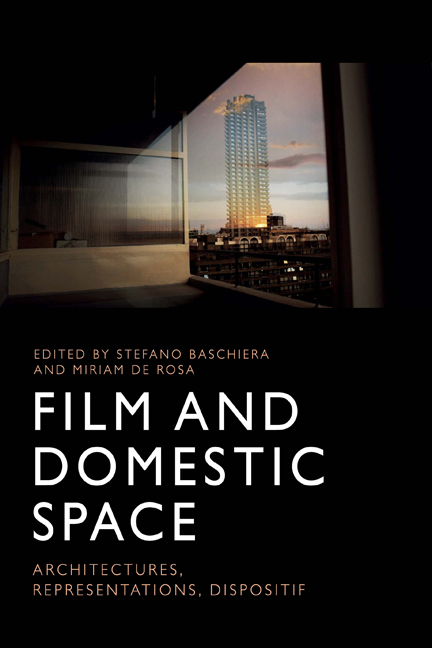Book contents
- Frontmatter
- Contents
- List of Figures
- Notes on the Contributors
- Acknowledgements
- Introduction
- 1 Architectures of Ubiquity: The Colonial Revival in Film and Television
- 2 No Down Payment: Whiteness, Japanese American Masculinity and Architectural Space in the Cinematic Suburbs
- 3 Resist, Redefine, Appropriate: Negotiating the Domestic Space in Contemporary Female Biopics
- 4 Liminal Spaces, Lesbian Desire and Veering off Course in Todd Haynes’s Carol
- 5 A Home on the Road in Claire Denis’s Vendredi soir
- 6 Acoustic Ectoplasm and the Loss of Home
- 7 Our House Now: Flat and Reversible Home Spaces in Post-war Film and Television
- 8 From Myth to Reality: Images of Domestic Space in Post-Soviet Baltic Films
- 9 No | Home | Movie: Essay Film, Architecture as Framing and the Non-house
- 10 At Home with the Nouvelle Vague: Apartment Plots and Domestic Urbanism in Godard’s Une femme est une femme and Varda’s Cléo de 5 à 7
- 11 Dwelling the Open: Amos Gitai and the Home of Cinema
- 12 What Is Cult When It’s At Home? Reframing Cult Cinema in Relation to Domestic Space
- 13 High-fructose Cinema and the Movie Industrial Complex: Radicalising the Technology of Representation in a Domestic Kind of Way
- Index
1 - Architectures of Ubiquity: The Colonial Revival in Film and Television
Published online by Cambridge University Press: 22 September 2020
- Frontmatter
- Contents
- List of Figures
- Notes on the Contributors
- Acknowledgements
- Introduction
- 1 Architectures of Ubiquity: The Colonial Revival in Film and Television
- 2 No Down Payment: Whiteness, Japanese American Masculinity and Architectural Space in the Cinematic Suburbs
- 3 Resist, Redefine, Appropriate: Negotiating the Domestic Space in Contemporary Female Biopics
- 4 Liminal Spaces, Lesbian Desire and Veering off Course in Todd Haynes’s Carol
- 5 A Home on the Road in Claire Denis’s Vendredi soir
- 6 Acoustic Ectoplasm and the Loss of Home
- 7 Our House Now: Flat and Reversible Home Spaces in Post-war Film and Television
- 8 From Myth to Reality: Images of Domestic Space in Post-Soviet Baltic Films
- 9 No | Home | Movie: Essay Film, Architecture as Framing and the Non-house
- 10 At Home with the Nouvelle Vague: Apartment Plots and Domestic Urbanism in Godard’s Une femme est une femme and Varda’s Cléo de 5 à 7
- 11 Dwelling the Open: Amos Gitai and the Home of Cinema
- 12 What Is Cult When It’s At Home? Reframing Cult Cinema in Relation to Domestic Space
- 13 High-fructose Cinema and the Movie Industrial Complex: Radicalising the Technology of Representation in a Domestic Kind of Way
- Index
Summary
The Colonial Revival house is an unavoidable context in cinematic and televisual representation. The ubiquity of Colonial Revival architecture – in the American landscape and in film and television – means that as a signifier it is both too empty and too full; there would appear to be too little and too much to say about this subject. The problem of Colonial Revival architecture itself is that it is an architecture of surfaces, appearances, facades, exteriors: it is a skin, the skin, we might say, of national fantasy. For not only is the term Colonial Revival in architectural history a loose, floating, perhaps even radically empty signifier (empty perhaps – as well – because overfull with too many contents), in actual architectural materiality, the term names the look of a house's exterior but indicates very little about the disposition of its interior spaces.
In a book dedicated to thinking about the house in American cinema, I have argued that when we look at houses on screen we are looking at what I call a ‘spectacle of property’. Whatever the nature or style or dimensions of the houses we see on-screen, when we look at a cinematic image of a house, we are in thrall to and enthralled by property, its images and its image-ness (Rhodes 2017). Cinema turns cinemagoers into shortterm tenants, whom I call ‘spectator tenants’ – subjects who (in the traditional context of theatrical moviegoing) ‘pay for the right to occupy a space in order to gaze up at a space they can never occupy’ (Rhodes 2017: 13 [italics in original]). This looking is structured slightly differently and receives different inflections according to the style of architecture that is being looked at. In the case of Colonial Revival architecture, an architecture of ubiquity, we seem to be looking at the omnipresent and inescapable nature of the property relation itself, a relation that houses and structures our intimate relationship to capitalism. Moreover, this architecture's emptiness, the lack of connection between its surfaces and its interiors, its malleability, plasticity, nominalism of reference and endless iteration (it is a ‘revival’ style, after all) mean that its architecture and moving images provide refracted but highly concrete embodiment of the endless fungibility of property relations in twentieth-century capitalism.
- Type
- Chapter
- Information
- Film and Domestic SpaceArchitectures, Representations, Dispositif, pp. 16 - 36Publisher: Edinburgh University PressPrint publication year: 2020



